On any other day, I would have passed by the spartan, crumbling building without a glance. On this day, however, Viking River Cruises had invited me to visit a Kommunalka, a communal living arrangement that is still practiced by a large percentage of residents in St. Petersburg, Russia.
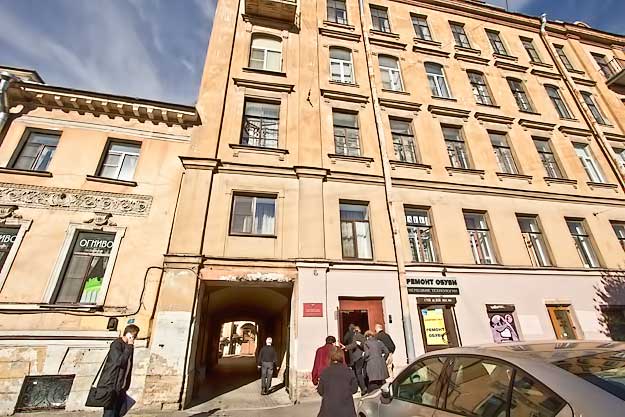
Across the interior courtyard, a heavy metal door opened onto a gloomy corridor where we groped our way up granite steps chipped and worn from decades of use. At the top, a long, mustard-colored hallway was crammed with makeshift storage cupboards, footlockers, and discarded furniture. We walked single file to the end, which opened onto an L-shaped kitchen and two bathrooms that are shared by residents of the eight apartments on the second floor.
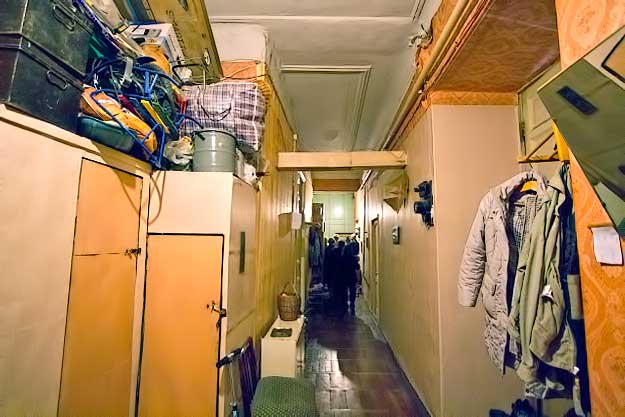

Kommunalkas were carved from aristocratic mansions seized by the State after the Revolution of 1917. Because they were never intended to house multiple families, common areas are rife with makeshift construction. Wiring for eight washing machines and eight stoves in the kitchen was loosely tacked to interior walls. In one of the bathrooms, a clawfoot tub with missing legs was shored up by stacked wood. Dilapidated wooden cabinets were covered with shelf paper in an attempt to create sanitary food prep surfaces for each of the eight apartments. Every inch of the common area screamed for a deep cleaning. Shocked, I followed our guide into the apartment of Irina, not knowing what to expect.
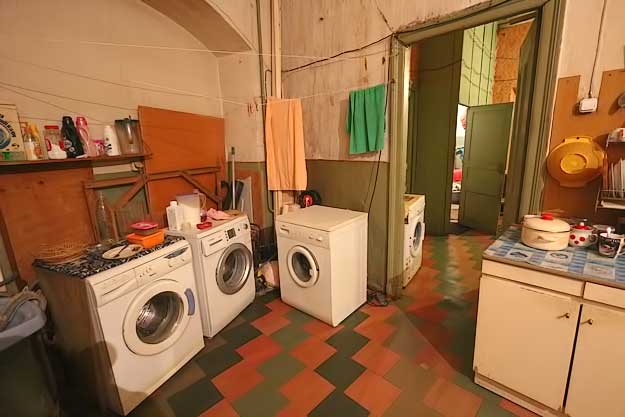
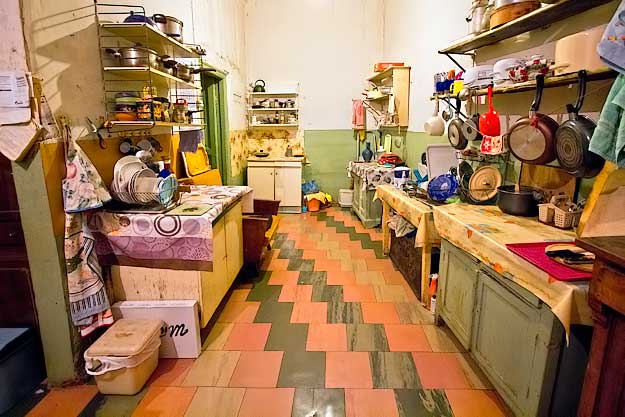
It was a bit like falling down the rabbit hole. Irina’s apartment was a spotless wonderland. A tall wooden credenza near the entry had been placed so as to carve out a small bedroom with twin beds, which Irina shares with her daughter and granddaughter. A long table had been set up in the great room that functioned as combination living/dining room. Tall windows were hung with floor-length drapes and sheers, while her walls were covered with tasteful wallpaper. Her flat-screen TV receives 140 cable channels, including world news programs, and she is free to surf the worldwide internet on a modern computer. Within her walls, everything, including a tall refrigerator, was shiny and modern.

Over tea and coffee cake, with the assistance of a translator, Irina told us about life in a Kommunalka. Communal living in the Soviet Union began early in the 20th century when the country entered the industrial era. Prior to the revolution, nearly 80% of Russians lived in the country; by the 1990’s, nearly 80% lived in urban areas, many through forced relocation programs. This shift in population caused a severe housing shortage. Lenin solved the problem by seizing private apartments from the bourgeois class and converting them to communal apartments, in some cases forcing up to 16 families to share a single floor of the prior mansions. When Khrushchev became premiere in 1953, he began turning over the apartments to residents, believing that granting them ownership would result in greater support for the communist system.

Aside from the fact that she now owns her apartment outright, Irina says her life is about the same now as it was under communism. “I was middle class then and I still consider myself to be middle class,” she says. “The biggest difference is that in years past, people cooked together, celebrated holidays together. Now everyone does their individual thing.”
The Kommunalka I visited, though clearly dilapidated, is considered prestigious by its residents, mostly for its prized location in the city center, but also for its high ceilings and rooms that are more spacious that the cookie-cutter apartment buildings that have sprouted in the suburbs. It does, however, have its challenges. Though Irina is responsible for maintenance within her own four walls, in theory the local government housing office is still responsible for the common areas and the exterior of the building. In reality, it can take months for repairs to be addressed and even then the complete cost may not be covered. Owners are often forced to share in the cost of major repairs, an extreme hardship given that greater than 75% of all Russians still earn less than $595 per month and 29% makes less than $315 a month (according to ForbesMagazine).

Keeping the common areas clean is the responsibility of the owners on each floor, and some inevitably feel they are doing more than their equitable share of the work. With only two bathrooms and one sink to serve eight apartments, residents must agree upon a schedule for bathing and cooking, thus quality of life in a Kommunalka is largely dependent upon how well the individual occupants get along and work together. Irina is one of the lucky ones. She has a good relationship with her neighbors and is comfortable with her living situation. Like so many other residents of St. Petersburg, Irina seems to have no desire to sell her kommunalka apartment and move to more modern housing.
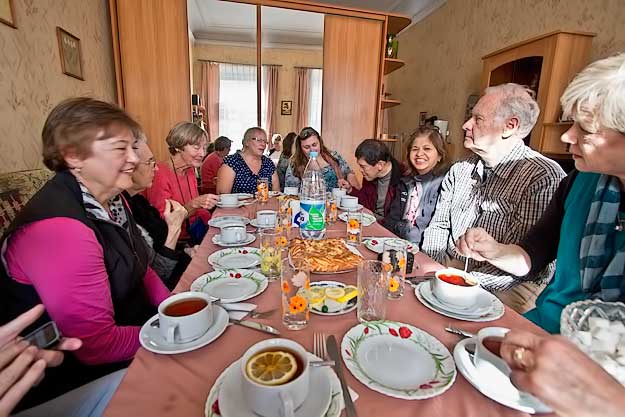
Disclosure: I was a guest of Viking River Cruises during my Waterway of the Tsars cruise. However, the receipt and acceptance of complimentary items or services will never influence the content, topics, or posts in this blog. I write the truth, the whole truth, and nothing but the truth.

Very nice honey covered story of communalkas.
In StP here is still around 80 000 communalkas and most of them are no way near as nice as the one you saw.
…asking to visit them as a foreigner/tourist is like insult.
How about if I would ask to visit in Spain, Italy or what ever country to see how poor people are living ?
Please, forget it.
For three generations my family lived in Kummunalkas in Peters. They now live in America and are happy about it.
I can imagine they are David. I sure wouldn’t want to live in one of them.
I lived 24 years in the kommunalka in the centre of St Petersburg and I can share my experience!
Hi there,
I’m Andrea and I’m writing a book set in St Petersburg in the 1950’s and 1960’s. Did you live in a communal apartment in the 1950’s? How difficult is communal living? What is the worst part of it? What is the best? How far were you from the Kirov Plant? What was the name of your street. Was it difficult to get from there to the University? I need to know how you would travel by tram rather than Underground as the underground didn’t work at the time I am writing about. I would really appreciate your help. Thank you.
Hello Andrea: I encourage you to go back to my blog and re-read the story. I have never lived in Russia. I was on a Viking River tour and they arranged for us to visit an apartment in a Kommnunalka one afternoon, so I obviously would have no way to answer your questions.
Half of Saint-Petersburg are living in kommunalkas
That’s my understanding as well, Andrew.
I will be in St. Petersburg in September and would like to visit a kommunalka but have not been able to find any listings. Do you have any contact information how to visit this one, please?
I’m sorry Sandy but I don’t. Everything was arranged by Viking River Cruises.
is there kommunalka yet in S.Piter?
and where ? i would like to know if them rent it
Wow. I didn’t know that they still had those. It looks quite sad, I must say.
St. Petersburg is great, isn’t it. It can surprise you any time!
Hi Jo: The common areas were pretty rough, but inside the apartments were quite nice, which I understand is the norm. No one wants to spend money on areas that they don’t actually own.
Kinda like forced hostel living … glad it worked out for the people in the story, but I wouldn’t be happy about it if it were me!
LOL Kyle. I stay in hostels most of the time, but even I couldn’t do this!
Well a little bit different place to stay on your travels, but probably better than a lot of student accommodation ! Interesting and fun i would think for a short time, looks like a great destination to explore too
Hi Tony: I didn’t actually stay in the Kommunalka; I just visited for the day.
Fascinating! I have been to St Petersburg and been to dinner at a private residence, a small apartment. That visit is a cherished event. I have had no idea about the kommunalka and wonder if my Russian friends will tell me about them. I suspect that there are certain aspects of Russian life that are not easily shared by Russians who have been guests in American homes.
Hi Beth: Irina was only too happy to tell us about her life in the Kommunalka, and there was another apartment owner on the same floor who was also working with Viking, so I don’t think it’s a big secret. I’d love to know if they would tell you about Komumnalkas if you are still in touch.
Really fascinating that this is still being practiced. Do you know if is it usually by older residents who lived in them during the USSR, or do people from other living situations seek out Kommunalka as well? It seems silly for there to be one room with a kitchenette, stove and washing machine for each resident, rather than having these items be shared, but I guess in this case the idea of “communal” only stretches so far.
Hi Semi: Form what I was told, Kommunalka apartments are used by all ages. They are apparently quite popular with university students and singles who are just entering the work force, who rent them from the owners.
Semi,
I am an American living in St. Petersburg for the past 7 years. I have several friends in their twenties who own rooms in communal apartments. I think it is an attractive option for many because–like the article says –many of the communal apartments are in the historical center of the city. Also, buying a room is usually much more affordable than a whole apartment.
Hi Aaron: Thanks so much for sharing that info with me and my readers. Seeing the Kommunalka lifestyle was probably the highlight of my trip.
Could you put me in touch with anyone who would be willing to show me their kommunalka?
Sorry Sandy, but those arrangements were made by Viking River Cruises and I have no contact information.
Thanks a lot for this virtual visit to Kollunalka. Though I come from the former USSR myself, I’ve never experienced what it’s like to live in a place like this.
It was really fascinating, Antonina. I’m afraid it wouldn’t be for me, even though I stay a lot in hostels, but Irina seemed quite content with her apartment.